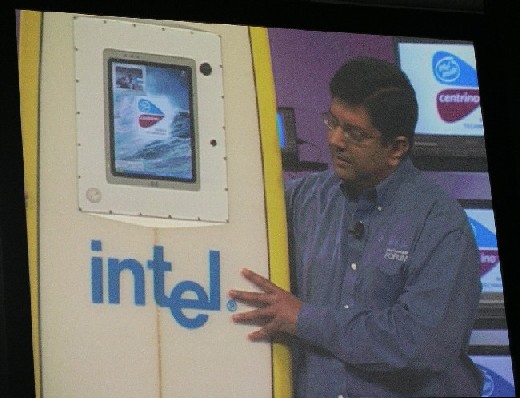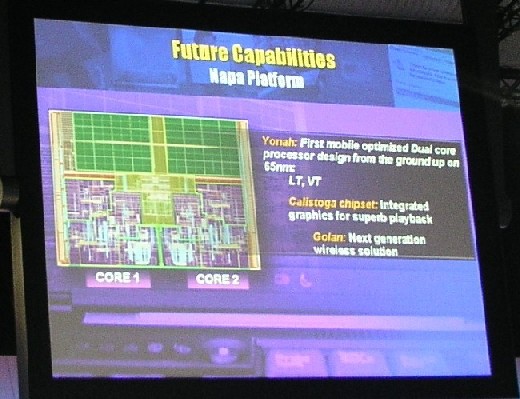
Anand with his Centrino equiped Surfboard - they must be riding the wave.
The mobile market is different from the desktop market, it is more of a concentrated market. People have needs and wants from their mobile computers and it is important for these to be met, currently the market wants connectivity, performance, battery life, and form features.
Intel are going to address all of these and have 3 areas which they believe they need to focus time and R & D upon:
1. Security – and mobile aware software
2. New Platform Capabilities
3. Extended battery life.
Within the business market, over 40% of people are working from a mobile position; Intel believes this will grow to 66% by 2005. This is no longer an emerging market, it is the main market in which Intel wants to play.
In order to achieve the core aims outlined above, Intel will be working on a number of different solutions. For example Intel will be providing a tool for developers to help port software between different platforms – optimized for battery life and other requirements.
One of the major drawbacks of the move to wireless connectivity is the security considerations. WiFi has got a lot of press both positive and negative, people have talked about the ability to hack networks from carparks and the like. Intel have had to look at this seriously and have created methods which allow secure authentication and handshakes in order to grant access to the network.
This new method also checks for viruses and security breaches, this will then be proactive and allow you to remove them before accessing the network. This removes the need for helpdesk support when trying to connect.
What would IDF be without more information on the next ‘Centrino’ platform? Well, Intel are working on their next solution: Sonoma, due for release in Q1 2005. Intel have seen massive market adoption and this will have more power and performance, including desktop technology such as DDR2, HDA audio, PCI-Express TV Tuner support and soon, in turn HDTV support.
On a longer time length Intel is talking about their next generation dual core. This has been designed from the ground up using 65nm technology. It has optimized power management, if you don’t need both cores then it won’t power both cores. This new technology code named Napa will have LT and VT technology within it. It will also feature; Yonah (Code name for the CPU), Calistoga – integrated graphics, Golan – Next Gen Wireless solution.

All of this new technology is good, but without the improvements in battery life then we may not see the adoption that Intel is planning. We have been seeing a steady increase of 3% a year on battery performance. The aim is to have an 8 hour battery life, with work being conducted at different levels: transistor, display, power state management, and battery technologies.
The core way which Intel can have a 3W reduction instantly in battery usage is with the use of Power Savings, these are provided by HDA, Low Power Panels, Display power saving technology, Intel application accelerator and DDR2.
Intel have 2 new battery technologies which they are working on – in the form of Pionics and Zinc Matrix. Both of these offer higher density battery cells with longer performance.
New ACPI 3.0
1. Enables lowest power dual core operation
2. Reduces disiplay power consumption
3. Enables os level standard battery recalibration.
Intel are moving in 3 ways.
1. More secure, mobile aware software
2. New platform capabilities
3. Extended battery life.
Anand believes they can double again the number of mobile products sold on the market in the next 4 years.













